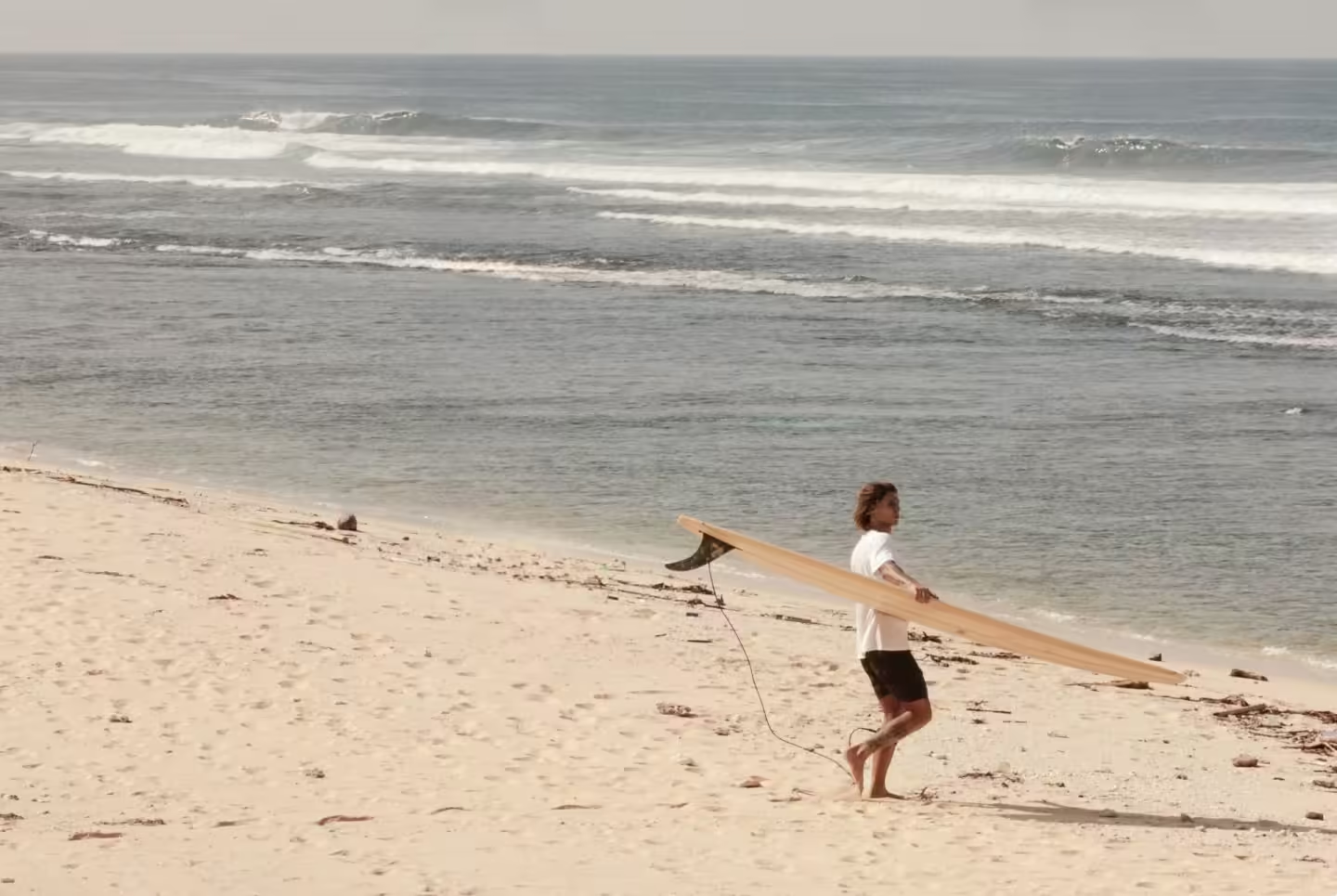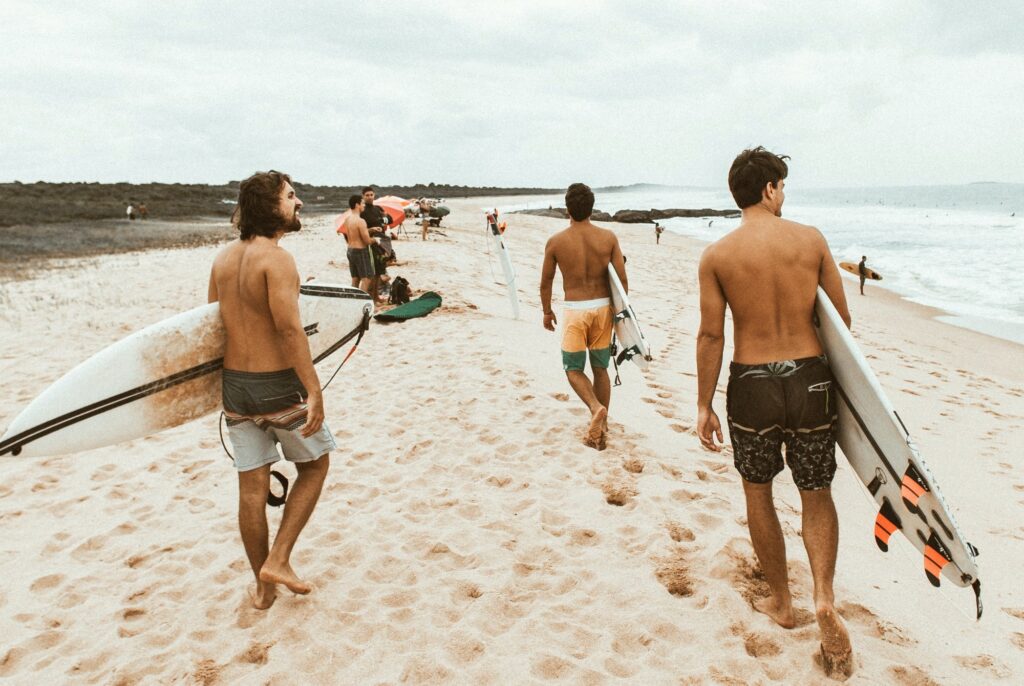What Do Surfers Wear When Surfing?
One of the best surfing about surfing is its simplicity, and it’s not just about the lifestyle of surfing, that embraces minimalism and a chill attitude, but it’s also about the equipment needed to glide the waves.
Just like any other activity, there’s an outfit that goes with surfing, and luckily, you don’t need quite a lot of equipment to ride the waves. There are a couple of few items you’d need to wear while surfing, depending on conditions and weather.
As surfing is very much dependent on weather conditions, wearing the right equipment will help a lot and offer more protection.
The right clothes and gear can make a difference when you’re catching waves and shredding them into oblivion, while also protecting you from sunburns, scratches, jellyfish stings, and much more.
At first, all you need is the essentials: a surfboard, wax, and wetsuit – the quintessential surf starter kit.
But as you progress and become the surf king/queen you were born to be, you’ll want more than just the basics.
What should a surfer wear then while surfing? Read on to find out all the surf essentials.
Complete your surfer look and elevate your style with unique masterpieces.
Surfcasual offers the ultimate collection of comfy surfer’s t-shirts that perfectly blend class and stoke.
Explore our exclusive collection here.
The Wetsuit
In many cases and especially in the winter or just a cold ocean, a wetsuit is the most important item of clothing for a surfer.
The wetsuit, crafted from neoprene, is the secret to a long and comfortable surf session in colder or cooler waters.
There are two main variations – the spring suit and full suit – and three thickness options – 5/4mm, 4/3mm, and 3/2mm.
Determining the appropriate thickness or variation of your wetsuit comes down to one simple factor – the temperature of the water you’ll be surfing in.
Here’s a quick overview of when to wear each variation:
- 5/4mm – Wetsuits labeled with a 5/4 thickness boast a hearty 5mm layer on the torso, with a slightly lighter 4mm thickness on the arms and legs. These sturdy suits are best suited for braving the colder waters of places with temperatures below and around 55°F (12°C).
- 4/3mm – Wetsuits with a 4/3 designation boast 4mm of thickness on the torso and 3mm on the arms and legs. A very common wetsuit thickness that is Ideal for surfing in cool to chilly conditions with temperatures between 55-65°F (12-18°C).
- 3/2mm – Another popular thickness choice, wetsuits marked with a 3/2 designation offer 3mm of thickness on the torso and 2mm on the arms and legs. Perfect for mild to cool temperature waters with temperatures above 65°F (18°C).
- Springsuit – When the temperature of the ocean heats up, you might only require coverage on the upper half of your body. You can then go for a springsuit – a shorter version of a full wetsuit. Springsuits offer the same thickness options as their full-suit counterparts, with arms and legs ending at the elbow and knees respectively.
The perfect wetsuit should be a snug fit that provides warmth the moment you dip into the water.
Wearing it should be a bit of a challenge when it’s dry, but once it’s on, it should hug your arms, legs, and torso comfortably without restricting your movements.
In addition to keeping surfers warm, wetsuits serve another important purpose: protection from marine life stings.
Surfing in the ocean means sharing the waves with a diverse array of creatures, some of which can deliver a painful sting.
A high-quality wetsuit provides a barrier between the skin and these stinging organisms, reducing the risk of painful encounters.
The neoprene material used in wetsuits is designed to deter stinging creatures such as jellyfish and sea lice.
The tight fit of the suit also helps prevent any unwanted skin exposure, further reducing the risk of stings.
If you’re not ready to buy a wetsuit or unsure of how cold would it be, it is wiser to rent one at your local surf spot.
Most places offer wetsuits for rent and this way you could test out the waters and decide which one you’d need or if you actually need one.
The Rash Guard
Surfers wear rashguards for sun protection and to avoid any skin abrasions from the surfboard. It’s basically a tight-fitting, lightweight short or long-sleeved shirt made of spandex and lycra.
Rash guards are also great for preventing discomfort from the constant friction between the surfboard and your body while paddling out or riding a wave and it gives you extra protection against the sun.
Most of them are made to be worn under your wetsuit, so between your body and your wetsuit but they can also be worn alone in warm or slightly chilly waters, making them ideal for summer surfing.
Rashguards should fit snugly and come in a variety of colors and prints so you can pick one that reflects your style.
The Boardshorts — For Men
If the weather is warm enough, this is essentially you’ll only need a pair of these. They’re definitely the most popular choice for a summer surf session and besides a surfboard, you don’t need any other clothing.
You can either go with regular volley shorts or swim trunks when it’s hot. Board shorts are usually made with quick-drying fabric and feature a drawstring for adjusting the fit.
They also come in various lengths and styles, from full-length to knee-length shorts. Boardshorts are great for guys since they come with pockets and extra stretchability for movement.
Even further, you can find boardshorts with removable padding and pockets for carrying small items such as car keys, wax, and other essentials.
Note that you can also wear boardshorts underneath your wetsuit if the water is cold enough to wear a full wetsuit isn’t necessary but some extra warmth is needed.
This way, you’ll stay warm and avoid any chaffing from the wetsuit.
The Swimsuit — For Women
For women, a swimsuit is a perfect choice when surfing. It’s important to have a secure swimsuit while surfing.
We suggest choosing a sturdy bikini or a one-piece that won’t slip off because the last thing you want is to fall off from your board and then realize the same happened to your swimsuit.
To avoid such embarrassing situations, we recommend avoiding strapless, tie-top, or bandeau swimsuits for surfing, and instead opting for those with buckles or elastic, which are more suitable for the ocean.
Whether you prefer bikinis or one-piece suits as swimwear, both are perfectly suitable for warmer temperatures and can also be easily layered with a wetsuit in colder climates.
Boots, Gloves, and Hood
For when the weather is extremely cold, and wearing only a wetsuit is not enough, you’d want to cover most of your uncovered body parts, such as your head, hands, and feet.
They are actually so handy in some situations as without them you just can’t surf at all, or you’ll suffer from hypothermia.
Neoprene Booties
When facing chilly or rocky waves, surf booties are a must-have accessory. Neoprene is a synthetic rubber material that is also used in wetsuits, as it provides insulation from cold temperatures and shock absorption.
These neoprene-made foot protectors come in varying sizes and styles, including traditional and split-toe options, to keep your toes warm and safe.
Neoprene Gloves
Another neoprene item that is important in a rocky environment or cold-water surfing is gloves. They provide extra insulation and protection against the frigid temperatures of the ocean.
Surfing in cold water can be uncomfortable, so it’s important to keep your hands warm (and alive).
Surf gloves are a lifesaver for surfers braving the cold waves, and can also come in handy in rocky, shallow waters to protect your hands from cuts and scratches. Also, make sure you look for gloves with rubber grips on the palm.
Neoprene Hood
And for extra warmth, a hood is a great investment when it comes to surfing in cold conditions.
The best hoods are made with neoprene and provide full coverage of the head and face for insulation.
Hoods usually fasten around your neck with a drawstring or Velcro closure and should be made of the same neoprene material as the boots and gloves.
Gloves, boots, and hoods are essential when surfing in cold conditions, as these are the body parts that get cold easily.
By having all these pieces of clothing in your arsenal, you’ll be ready to tackle most kinds of weather conditions.
Sunscreen
Last but not least, sunscreen is an absolute must for any surfer. Even if the sky looks cloudy, UV rays from sunlight can still reach your skin and cause sunburn or harm it.
Sunscreen with an SPF of 50 or higher is recommended for all-day protection against sunburns, wrinkles, and skin cancer.
And as surfers are exposed to the sun’s UV rays, it’s crucial to put on sunscreen every time you go surfing.
Be sure to apply sunscreen liberally and frequently, especially if you’re out surfing for even an hour, and make sure to reapply every two hours.
What Do Surfers Wear When Not Surfing?
When the surf session ended and it comes to beach attire, surfers tend to stick with the classics. That means graphic or logo t-shirts paired with shorts or swim trunks.
The key is to make sure your clothes are lightweight and have a minimalist vibe. Surfers love to rock streetwear styles like hoodies, graphic tees, and denim jeans or shorts.
For extra style points, look for pieces with an edgy vibe – think distressed denim jackets and ripped jeans – or Hawaiian-inspired prints like palm trees or tropical flowers.
Finish off the look with some classic sneakers or slip-on sandals and you’ve got yourself a great surfer style.
If you want to learn more about how to dress like a surfer, read our recent detailed guide for how to elevate your surfer clothing style.
Final Thoughts
The most important rule for what to wear when going to surf is depending on the weather and water conditions.
If it’s a cold winter then you need to put on a full-body wetsuit and some quality neoprene clothing to keep yourself warm.
In this case, it’s no recommendation but a vital requirement. On the other hand, if you’re surfing in warmer weather, then it’s more about styling and finding pieces that are comfortable, as you’d basically need only boardshorts, and that’s it.
No matter what you choose, wearing the right clothing and accessories is essential to ensure your safety and comfort when out in the water.
So next time you’re at the beach you’ll know what you should be wearing.



